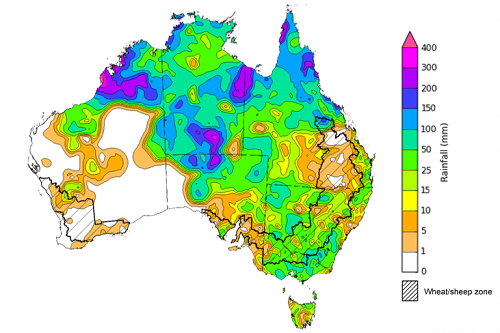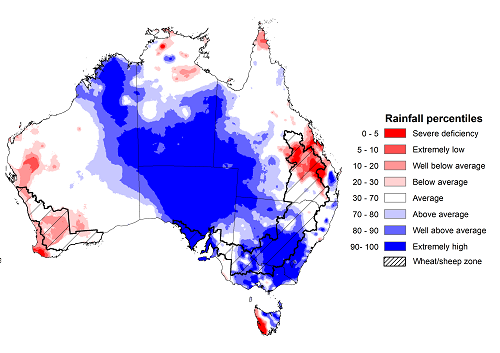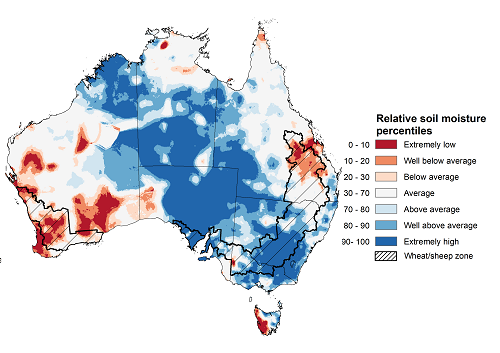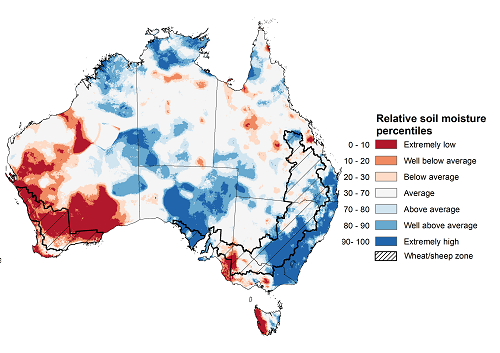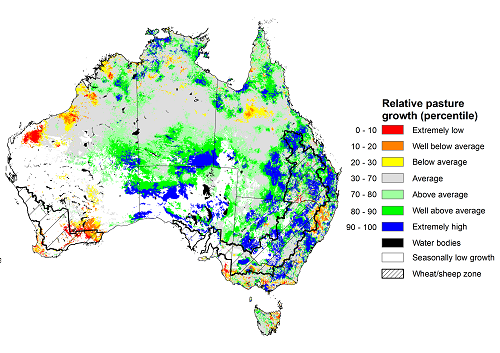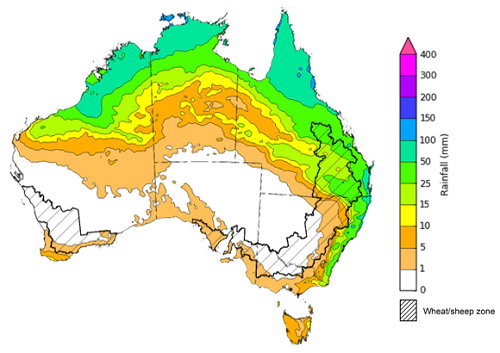Key issues
- For the week ending 2 February 2022, low-pressure troughs across much of Australia drew down tropical, moist air, resulting in heavy rain and storms in large areas of northern and central Australia, as well as rainfall in south-eastern Australia.
- Dry conditions across southern Queensland likely improved field access for the harvesting of early sown summer crops to continue without delay. However, dry conditions in the Central Queensland growing region, is likely to delay the germination of late sown summer crops. The rainfall across much of New South Wales will support yield potential of summer crops as they near flowering.
- January 2022 was wetter than normal compared to the January long-term average. Below average rainfall in Queensland during January would have benefited the harvest of early sown summer crops. Across New South Wales and southern Queensland, average January rainfall would have provided ideal growing condition for summer crops and pastures, however, it may also have led to some disruptions in the harvest of early sown summer crops.
- Lower layer soil moisture for January 2022 was well above average to extremely high for this time of year across parts of south-eastern, south-central and northern Australia. High levels of lower layer soil moisture will continue to support above average yield prospects for summer crops and above average pasture growth rates for this time of year across New South Wales and southern Queensland.
- Average to extremely high pasture production across much of New South Wales, Victoria Queensland, South Australia and the Northern Territory will likely enable farmers to continue to rebuild stock numbers and provide opportunities to replenish fodder supplies during late spring and early summer.
- Over the 8-days to 10 February 2022, rainfall is expected to be restricted to northern and part of eastern Australia. A monsoonal trough is expected to bring heavy rain and storms to large areas of Australia’s tropical north, while onshore winds are expected to bring showers along the eastern seaboard.
- The forecast rainfall for cropping regions in Queensland may further prevent the harvest of early planted summer crops. However, the falls are likely to benefit pasture growth and build upper layer soil moisture levels benefitting the germination of late sown summer crops.
- Water storage in the Murray–Darling Basin (MDB) increased by 105 gigalitres (GL) between 26 January 2022 and 2 February 2022. The current volume of water held in storage is 22,535 GL, which represents 89% of total capacity. This is 64% or 8,784 GL more than at the same time last year.
- Allocation prices in the Victorian Murray below the Barmah Choke decreased from $92 per ML on 21 January 2022 to $85 per ML on 28 January 2022. Prices are lower in the Goulburn-Broken, Murrumbidgee, and regions above the Barmah Choke due to the binding of the Goulburn intervalley trade limit, Murrumbidgee export limit, and Barmah Choke trade constraint.
Climate
For the week ending 2 February 2022, low-pressure troughs across much of Australia drew down tropical, moist air, resulting in heavy rain and storms in large areas of northern and central Australia, as well as rainfall in south-eastern Australia.
Rainfall totals of between 10 and 100 millimetres were recorded across much of New South Wales, Victoria and the Northern Territory, western and northern Queensland and Tasmania, as well as northern parts of South Australia and Western Australia. Rainfall totals in excess of 100 millimetres were recorded across parts of northern Queensland, South Australia and Western Australia, and across large areas of the Northern Territory.
In cropping regions, rainfall totals of between 10 and 50 millimetres were recorded across much of New South Wales and Victoria, as well as parts of central South Australia. Rainfalls in excess of 50 millimetres were recorded in isolated parts of New South Wales and northern Queensland cropping regions. Little to no rainfall was recorded across remaining cropping regions in Queensland, South Australia and Western Australia.
Dry conditions across southern Queensland likely improved field access for the harvesting of early sown summer crops to continue. However, dry conditions in the Central Queensland growing region, is likely to delay the germination of late sown summer crops. The rainfall across much of New South Wales will support yield potential of summer crops as they near flowering.
Rainfall for the week ending 2 February 2022
Note: The rainfall analyses and associated maps utilise data contained in the Bureau of Meteorology climate database, the Australian Data Archive for Meteorology (ADAM). The analyses are initially produced automatically from real-time data with limited quality control. They are intended to provide a general overview of rainfall across Australia as quickly as possible after the observations are received. For further information go to http://www.bom.gov.au/climate/rainfall/
Rainfall during January 2022 was 22% above average for Australia as a whole. However, severely deficient to below average rainfall was recorded across western Tasmania, parts of the west of Western Australia, and an area of eastern Queensland across the Central Highlands and Coalfields, the Central Coast, Capricornia and northern parts of the Wide Bay and Burnett districts. In contrast, areas of above average to extremely high rainfall were recorded across much of New South Wales, western Queensland, Victoria, South Australia, north-eastern Western Australia, north-east Tasmania and the central and southern parts of the Northern Territory.
The active La Niña event on the Pacific was the main climate influence during the month. Extremely high rainfall total across the south-east, centre and north of Australia were associated with the movement and break down of ex-tropical cyclones Seth and Tiffany.
January rainfall was average to above average across cropping regions of New South Wales and southern Queensland, Victoria and South Australia, with below average falls dominated cropping regions in northern Queensland and Western Australia.
Below average rainfall in Queensland during January would have benefited the harvest of early sown summer crops. Across New South Wales and southern Queensland, average January rainfall would have provided ideal growing condition for summer crops and pastures, however, it may also have led to some disruptions in the harvest of early sown summer crops
Rainfall percentiles for January 2022
Upper layer soil moisture in January 2022 was average for this time of year across most of Queensland, northern Western Australia and the north of the Northern Territory, despite a dry start to the month in these areas. Modelled upper layer soil moisture was extremely low for parts of central Queensland, southern and central areas of Western Australian, as well as western Tasmania due to below average rainfall in these areas during January. Extremely high soil moisture was evident across large areas of New South Wales, western Queensland, Victoria, South Australia, the north and east of Western Australia, as well as southern and central parts of the Northern Territory, reflecting the heavy rainfall in the latter parts of January.
At this time of year, upper layer soil moisture is important for late planted summer crops in the Central Queensland growing region and for pasture growth across northern Australia since plant germination and establishment utilise this moisture. It is also important indicator of the ability to access paddocks to undertake harvest and planting activities.
Upper layer soil moisture was average to above average for this time of year across cropping regions in northern New South Wales and southern Queensland. Upper layer soil moisture was extremely low to average for much of the Central Queensland growing region. Extremely high to above average upper layer soil moisture was evident across much of New South Wales, Victoria and South Australian cropping regions. Average levels of upper layer soil moisture would have allowed paddock access for harvesting of early planted summer crops in northern New South Wales and southern Queensland. Meanwhile, the below average upper soil moisture levels in Central Queensland growing region may impede germination of late planted summer crops.
Modelled upper layer soil moisture for January 2022
Lower layer soil moisture for January 2022 was well above average to extremely high for this time of year across parts of south-eastern, south-central central and northern Australia. Lower layer soil moisture was well below average to below average across the much of Western Australia and western Tasmania, as well as along the southern border between South Australia and Victoria.
In cropping regions, lower layer soil moisture was well above average to extremely high for much of southern and central New South Wales, parts of southern and northern Queensland, as well as central and western parts of South Australia. High levels of lower layer soil moisture will continue to support above average yield prospects for summer crops and above average pasture growth rates for this time of year across New South Wales and southern Queensland.
Modelled lower layer soil moisture for January 2022
Pasture growth during the November to January period is the peak pasture growth period which typical provides a bulk of feed to maintain production through the low pasture growth months of the northern dry season. Across southern Australia, November to January pasture growth is typically low reflecting lower rainfall totals, high temperature and high evapotranspiration rates at this time of year. Pasture availability during this period influences the growth and branding and marking rates of lambs and calves, livestock turnoff and the production of meat, milk, and wool.
For the 3 months to January 2022, above average rainfall totals and mild temperatures resulted in average to well above average pasture production for this time of year across most grazing regions in New South Wales, Queensland, northern Victoria, South Australia, northern Western Australia and the Northern Territory. Extremely low to below average pasture growth rates were recorded across southern Western Australia, consistent with above average temperatures and below average rainfall.
Average to extremely high pasture production across much of New South Wales, Victoria Queensland, South Australia and the Northern Territory will likely enable farmers to continue to rebuild stock numbers and provide opportunities to replenish fodder supplies during late spring and early summer. Below average rainfall and well above average temperatures in Western Australia may have restricted late spring pasture growth, however, it comes after extremely high pasture growth during winter that supplied average to above average pasture availability.
Relative pasture growth for 3-months ending January 2022 (1 November to 31 January 2022)
Source: Queensland Department of Science, Information Technology and Innovation
Over the 8-days to 10 February 2022, rainfall is expected to be restricted to northern and part of eastern Australia. A monsoonal trough is expected to bring heavy rain and storms to large areas of Australia’s tropical north, while onshore winds are expected to bring showers along the eastern seaboard. Meanwhile, high pressure systems are expected to bring mostly dry conditions to much of southern and central Australia.
Rainfall totals of between 10 and 50 millimetres are forecast for the far east of New South Wales and Victoria, as well as much of eastern and northern Queensland, and the north of Western Australia and the Northern Territory. Rainfall in excess of 50 millimetres is expected across parts of the north of Western Australia and the Northern Territory, parts of northern and eastern Queensland and scattered areas of eastern New South Wales.
In Australian cropping regions, rainfall totals of between 10 and 50 millimetres are expected across as most of Queensland. Little to no rainfall is forecast for all remaining cropping regions during the next 8-days.
Soil moisture levels through the entire rootzone remain average to above average across most summer cropping regions. The forecast rainfall for parts Queensland may further prevent the harvest of early planted summer crops. However, the falls are likely to benefit pasture growth and build upper layer soil moisture levels benefitting the germination of late sown summer crops. The heavy rainfall forecast for much of Northern Australia will continue to boost soil moisture level and pasture growth rate dung this peak production season.
Total forecast rainfall (mm) for the period 3 February to 10 February 2022
Note: This rainfall forecast is produced from computer models. As the model outputs are not altered by weather forecasters, it is important to check local forecasts and warnings issued by the Bureau of Meteorology.
Water
Water storages, water markets and water allocations - current week
The Tableau dashboard may not meet accessibility requirements. For information about the contents of these dashboards contact ABARES.
Commodities
Information on weekly price changes in agricultural commodities is now available at the Weekly commodity price update.

